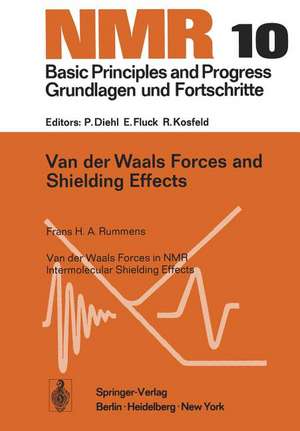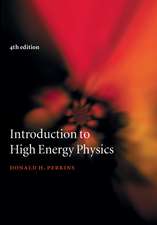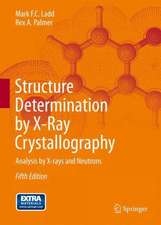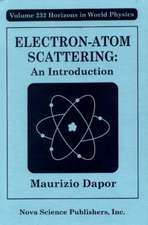Van der Waals Forces and Shielding Effects: NMR Basic Principles and Progress, cartea 10
Autor Frans H. A. Rummensen Limba Engleză Paperback – 9 feb 2012
Din seria NMR Basic Principles and Progress
-
 Preț: 384.48 lei
Preț: 384.48 lei - 15%
 Preț: 640.71 lei
Preț: 640.71 lei - 18%
 Preț: 951.47 lei
Preț: 951.47 lei - 15%
 Preț: 635.47 lei
Preț: 635.47 lei - 18%
 Preț: 1119.71 lei
Preț: 1119.71 lei - 18%
 Preț: 942.76 lei
Preț: 942.76 lei - 15%
 Preț: 635.47 lei
Preț: 635.47 lei - 18%
 Preț: 950.96 lei
Preț: 950.96 lei - 15%
 Preț: 647.92 lei
Preț: 647.92 lei - 5%
 Preț: 711.32 lei
Preț: 711.32 lei - 15%
 Preț: 574.95 lei
Preț: 574.95 lei - 15%
 Preț: 638.89 lei
Preț: 638.89 lei - 15%
 Preț: 636.63 lei
Preț: 636.63 lei - 15%
 Preț: 639.41 lei
Preț: 639.41 lei - 15%
 Preț: 639.59 lei
Preț: 639.59 lei - 15%
 Preț: 635.01 lei
Preț: 635.01 lei - 18%
 Preț: 944.67 lei
Preț: 944.67 lei - 18%
 Preț: 945.30 lei
Preț: 945.30 lei - 18%
 Preț: 940.39 lei
Preț: 940.39 lei - 15%
 Preț: 635.15 lei
Preț: 635.15 lei - 15%
 Preț: 634.68 lei
Preț: 634.68 lei - 15%
 Preț: 640.37 lei
Preț: 640.37 lei - 15%
 Preț: 637.13 lei
Preț: 637.13 lei - 18%
 Preț: 941.38 lei
Preț: 941.38 lei - 18%
 Preț: 940.72 lei
Preț: 940.72 lei - 18%
 Preț: 936.95 lei
Preț: 936.95 lei - 18%
 Preț: 937.09 lei
Preț: 937.09 lei - 15%
 Preț: 643.99 lei
Preț: 643.99 lei - 15%
 Preț: 635.96 lei
Preț: 635.96 lei - 15%
 Preț: 632.05 lei
Preț: 632.05 lei - 15%
 Preț: 633.53 lei
Preț: 633.53 lei - 15%
 Preț: 631.07 lei
Preț: 631.07 lei
Preț: 633.19 lei
Preț vechi: 744.93 lei
-15% Nou
Puncte Express: 950
Preț estimativ în valută:
121.16€ • 126.84$ • 100.25£
121.16€ • 126.84$ • 100.25£
Carte tipărită la comandă
Livrare economică 05-19 aprilie
Preluare comenzi: 021 569.72.76
Specificații
ISBN-13: 9783642661785
ISBN-10: 3642661785
Pagini: 128
Ilustrații: II, 122 p.
Dimensiuni: 170 x 244 x 7 mm
Greutate: 0.22 kg
Ediția:Softcover reprint of the original 1st ed. 1975
Editura: Springer Berlin, Heidelberg
Colecția Springer
Seria NMR Basic Principles and Progress
Locul publicării:Berlin, Heidelberg, Germany
ISBN-10: 3642661785
Pagini: 128
Ilustrații: II, 122 p.
Dimensiuni: 170 x 244 x 7 mm
Greutate: 0.22 kg
Ediția:Softcover reprint of the original 1st ed. 1975
Editura: Springer Berlin, Heidelberg
Colecția Springer
Seria NMR Basic Principles and Progress
Locul publicării:Berlin, Heidelberg, Germany
Public țintă
ResearchCuprins
and Foreword.- 1. Historical Development (Up to 1961).- 2. Continuum Models.- 2.1. The Continuum Model of Linder.- 2.2. The Continuum Model of De Montgolfier.- 2.3. The McRae Formula.- 3. Pair Interaction Models ?w.- 3.1. The Binary Collision Gas Model of Raynes, Buckingham and Bernstein.- 3.2. The Cage Model.- 3.3. Kromhout and Linder’s Quantum Mechanical Model.- 3.4. A Preliminary Comparison of the Various Models Suggested for ?w.- 4. Other Experimental Proton ?w Data.- 5. The Physical Nature of the Field $$ \ overline {{F^{2}}} $$ and of the Associated Excitation Energy.- 5.1. The Bothner-By Method.- 5.2. The Raynes-Buckingham-Bernstein (RBB) Method.- 5.3. Linder’s Model.- 5.4. De Montgolfier’s Method.- 5.5. The Method of Kromhout and Linder.- 5.6. An Empirical Test.- 6. The Site Factor.- 6.1. The Solute Site Factor of Rummens et al..- 6.2. The Solute-Solvent Site Factor of Raynes.- 6.3. The Solute Site Factor of De Montgolfier.- 7. The Repulsion Effect.- 7.1. The Repulsion Formulation in the Binary Gas Collision Model; Application to Effects on Protons.- 7.2. Repulsion Effects in 19F ?w Shifts.- 7.3. Repulsion Effects in 129Xe.- 7.4. Pressure Effects on ?w.- 8. The Effects of Higher Order Dispersion Terms.- 9. The Parameters B.- 9.1. Marshall and Pople’s Calculation of B for an H Atom.- 9.2. Calculation of B for H Atoms and Rare-gas Atoms According to Jameson, Jameson and Gutowsky.- 9.3. ?w of Two Interacting H Atoms According to Marshall and Pople.- 9.4. The Perturbation Calculations of Yonemoto.- 9.5. Kromhout and Linder’s Calculation.- 9.6. Empirical Determinations of B for Atoms and Non-polar Molecules.- 10. ?w in Dense Media.- 10.1. The Effects of Higher Order Collisions in Gases.- 10.2. The Gas-Liquid Transition.- 11. The TemperatureDependence of ?w.- 11.1. The Intramolecular Temperature Effect.- 11.2. d?w/dt in Gases.- 11.3. d?w/dt in Liquids.- 12. Factor Analysis.- 12.1. Introduction to the Formalism.- 12.2. Medium Effects as Product Functions.- 12.3. Applications of Factor Analysis.- 12.4. Criticism of the Factor Analysis Method.- 13. 19F ?w Studies.- 14. ?w of Nuclei other than 1H and 19 F.- 14.1 ?w of 13C and 29Si.- 14.2. ?w of 31P.- 14.3. ?w of 129Xe.- 15. Alternate Referencing Systems.- 15.1. Internally Referenced ?w Data.- 15.2. Externally Referenced Measurements.- 15.3. ?M and the Bulk Susceptibility Correction ?b.- 16. On the Required Molecular Parameters and Physical Constants.- 16.1. Bulk Properties.- 16.2. Molecular Properties.- 16.3. The Lennard-Jones (6–12) Force Constants ?/k and r0 and the Functions ?6(y) and S6g.- References.- Author Index Vol. 1–9.















